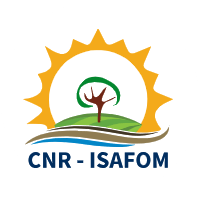Perugia
Responsible: Alessio Collalti
Via della Madonna Alta, 128 Perugia, Umbria
Tel: +39 075.5014.541
Perugia Branch - ISAFOM-CNR
Although the office has always focused on the development of innovative solutions for the olive sector and the valorisation of by-products from the olive-oil chain, it is also more recently integrating advanced competences in circular bio-economy, sustainable soil management, forest ecology and modelling.
Main Research Areas
1. Olive Growing and the Olive Oil Production Chain
- Prospecting and collecting olive germplasm (national and international)
- Bio-agronomic characterisation
- Oil and fat quality (HPLC, GC)
- Propagation and study of varieties, wild and subspecies
- Experimental fields for biodiversity and nutraceutics
2. Circular bio-economy
- Sustainable management and valorisation of agro-industrial waste (e.g. wet pomace) and urban waste (e.g. organic waste)
- Aerobic composting and co-composting (including use of biochar)
- Production of compost as a substitute for peat and synthetic fertilisers
- Agronomic and biological assessment of compost (stability, maturity, phytotoxicity)
- Prototype COMPOSTER for laboratory-scale composting
- Biodegradability and compostability testing of bioplastics with plant BIODEG
- Anaerobic digestion for energy recovery (biogas) and biofertiliser (digestate)
- Use of biofertilisers to recover organic matter and nutrients
- Biodegradable bioplastics in the municipal waste cycle and the environment
- Sustainable soil management
- Activities aimed at evaluating the effectiveness of organic soil improvers in restoring soil fertility.
- Both quantitative and qualitative analysis of microbial biomass as an indicator of soil health and vitality.
- Study of the storage capacity of organic carbon, both total and divided into its main fractions, in different ecosystem contexts.
- Assessment of soil quality status in truffle fields managed with sustainable agroforestry practices.
4. Modelling and Forest Ecology (https://www.forest-modelling-lab.com/)
- Quantitative and qualitative analysis of interactions in forest ecosystems
- Studying the response of forests to disturbances and climatic forcings
- Development, parameterisation and validation of models (e.g. 3D-CMCC-FEM)
- Simulations of management scenarios, climate impacts and long-term change
- Integration into decision support systems (DSS) for forest management
Services and Products Offered
- Study and conservation of olive biodiversity
- Chemical and biochemical analyses of olives and oils
- Recovery of by-products for bioenergy production
- Business support on environmental regulations and movement of goods
- Agronomic evaluation of composts, peat-free potting soils, digestates and other biofertilisers
- Biodegradability and compostability tests in accordance with EN ISO standards
- Soil analysis (chemical and biological fertility)
- scenarios on the impact of climate change and forest management on forest ecosystems
Technological Equipment
- Experimental camp in Tuoro sul Trasimeno (collections and crossbreeding)
- Workshops:
- Oils and fatty substances
- Soil and organic matter analysis (SOIL)
- Plant biotechnology
- Greenhouse and field trials
- Automated Composting (COMPOSTER)
- Respirometry and biodegradability (BIODEG)
- Experimental greenhouse (264 m²)
- Mini crusher
- Advanced analytical instrumentationincluding:
- ICP-OES
- Elementar Analyser (C, H, N, S)
- Reactor for IRDP
- SOUR Analyzer
- ProStar 335 DAD
- Biogas analyser
- FT-IR ATR
- HPLC
- GC
- GC-MS
Main Patents
- Olive tree varietiesFROM 12 I RESISTANT, FS 17 FABULOUS, DON CARLO, GIULIA
- Technologies:
- Production of hydroxytyrosol-rich eluates
- MATREF.O. for oil effluent treatment
3D-CMCC-FEM model
(https://github.com/Forest-Modelling-Lab/3D-CMCC-FEM)
A process-based model for complex-structure forests that simulates:
- Photosynthesis, respiration and water/energy balances
- Carbon allocation, growth and mortality
- Forest response to climate and management scenarios
- Integration in DSS and model intercomparison projects
International Projects
- TAIE (FIRST Programme, 2025-2028): Truffle Agroforestry Innovate & Empower
- FERBIOSOIL (MAECI-MOST, 2024-2027): Novel advanced biofertilizers from spent FERmentative BIOmasses for enhancing agriculture circularity and SOIL health
- ForestNavigator (H2020, 2022-2026): Forest Modelling for Climate Mitigation (https://www.forestnavigator.eu/)
- OptFor-EU (H2020 2023-2027)DSS for resilient forest management (https://optforeu.eu/)
- ISIMIP (2017 - ongoing): Inter-Sectoral Impact Model Intercomparison Project (https://www.isimip.org/)
National Projects
- ClicFor (PRIN 2022): influence of climate, from seasonal to decadal scales, on the carbon cycle in forests
- Waterstem (PRIN2020): Carbon-water interaction in Mediterranean ecosystems
- Multifor (PRIN2020): Forest responses to pollution and climate change
Scientific Collaboration Agreements
- College of Forestry, Beijing Forestry University (BJFU) China - Scientific Collaboration Agreement for Forestry Research, Communication and Outreach (from 2025)
- Biorepack srl - National Consortium for the Organic Recycling of Biodegradable and Compostable Plastic Packaging - Scientific Cooperation Agreement for research, communication and dissemination activities on environmental issues (from 2024)
- College of Natural Resources and Environment, Northwest A&F University (NWAFU), Yangling, Shaanxi, China - Scientific Collaboration Agreement for Forestry Research, Communication and Outreach Activities (from 2024)
- University of Padua, Land and Agro-Forestry Systems Department (UNIPD-TESAF) - Scientific collaboration agreement for research, communication and dissemination activities in forestry (from 2023)
- Gestione Servizi Aziendali srl - Agreement on scientific cooperation for environmental research, communication and dissemination activities (from 2022)
University of Tuscia of Viterbo, Department of Agricultural and Forestry Sciences (UNITUS-DAFNE) - Scientific collaboration agreement for research, communication and dissemination activities in forestry (from 2022)
Last update
19 June 2025, 11:57

 CNR - ISAFOM
CNR - ISAFOM